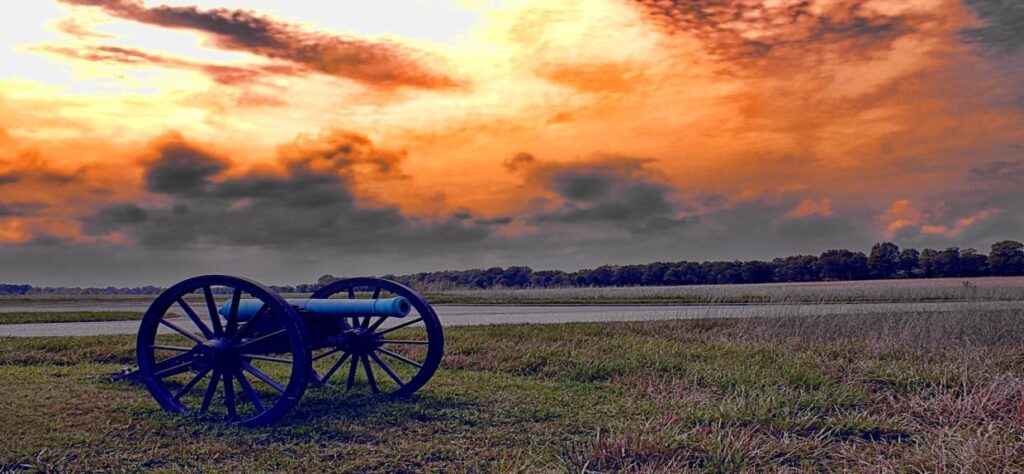It sounds like the script for a Hollywood movie. The story, first appearing in 2001, begins with a purported civil war legend from the Battle of Shiloh. The legend said that the wounds of some soldiers glowed (faintly) in the dark. Soldiers with these glowing wounds were more apt to survive, giving the phenomenon the name “Angels Glow”. The story ends with two curious teenagers solving the mystery using their science fair project. They identify infection by the bioluminescent bacteria Photorhabdus luminescens (formerly Xenorhabdus luminescens) as the likely cause of the glowing wounds. P. luminescens produces bacteriocins (antimicrobial peptides), which the teenagers attribute to helping keep other infections at bay, resulting in the improved survival rate for the soldiers whose wounds glowed.
The teenagers win. The mystery is solved. The credits roll.
Except life (and science) is rarely as simple as a summer block buster.

The Uncertain Origin of a Civil War Legend
There are all sorts of folklore and legends that date back to the Civil War. Unfortunately, “Angel’s Glow” doesn’t seem to be one of them. If you search for “Angel’s Glow” you will get a lot of results, but none date further back than 2001. According to one historian and former Shiloh National Military Park ranger, he’d never heard of the legend of “Angel’s Glow” until the story of the teenagers and the science fair broke in 2001 (1). This is notable because there is a lot of information available about the Battle of Shiloh, much of it in the form of contemporary accounts.
Much like scientists use experimental design and observation to gain understanding, historians use contemporary accounts— journals and letters written by those who witness events firsthand. That is why many Civil War buffs and historians have been scratching their heads about this story. More than 100,000 men fought in the Battle of Shiloh, and there are over 2,000 contemporary accounts from those who were there. None of these accounts mention soldiers with glowing wounds (1,2). Given that glowing people were no more common in 1862 than they are now, it’s hard to imagine that not a single soldier or doctor would mention them in a journal or letter home. And yet no one can find any reference to them or “Angel’s Glow.” Not from the Battle of Shiloh or anywhere else.
Just Because No One Wrote About It Doesn’t Mean It Couldn’t Have Happened
The caveat that historians face when using contemporary accounts is that absence of any mention of an event does not mean that event did not occur. In 1862, mentioning soldiers glowing, no matter how faintly, was likely to be met with disbelief or worse. In the aftermath of the first big battle of the Civil War, with over 23,000 soldiers dead, maybe no one wanted their superior officers or loved ones back home worrying that they had gone crazy. Still, if no one wrote about it, and if rangers at the site had never heard about it, you can’t help but wonder how (and when) did the legend start? Unfortunately, over 160 years later, there is no one left to ask.
Could P. luminescens Have Caused Wounds to Glow?
Sometimes science can shed light on historical mysteries; at least that was the premise of the 2001 story. But, if the mystery wasn’t real, is the answer science offered still valid? The answer seems to be—maybe.
P. luminescens, the reported source of “Angel’s Glow”, is a gram-negative bacterium that typically exists as a symbiont in the guts of nematodes that infect insects. As the name suggests, it does indeed produce a weak bioluminescent signal, which can be seen with the naked eye (if the eyes are given 10–15 minutes to adjust to the dark; 3). The bacteriocins released by P. luminescens help prevent other microorganisms from growing, thus helping its nematode host survive by minimizing competition from other microorganisms (4). And finally, although not often associated with human infections, there have been cases of P. luminescens infections reported in humans (3,4). While none of the wounds associated with the modern P. luminescens infections are described as healing inexplicably fast or documented as glowing, these wounds were also treated with modern antimicrobial therapies and were not observed in the same dark conditions that would likely have existed at night on a Civil War battlefield.
Is “Angel’s Glow” Civil War Folklore or Modern Myth?
Did the wounds of soldiers really glow in the darkness following the Battle of Shiloh? We will never know. The science suggests that P. luminescens infection could have occurred in the wounds of some soldiers after the battle, and we can’t eliminate the possibility that the bacteria in some of these infected wounds might have reproduced enough that the weak bioluminescent glow it emitted was visible to those close by.
So, is “Angel’s Glow” Civil War folklore or modern myth? The story certainly captures the imagination. It has all the elements that make you want it to be true: a Civil War legend; clever teenagers who solve a centuries-old mystery and win a prestigious science fair. Science suggests it could be possible, but with no documented firsthand accounts of the phenomenon, Civil War experts lean toward a more modern origin to the myth (1,2). It is a good story though, which is probably why it continues to circulate every few years. Maybe someone should make the movie?
References
- Some Civil War Soldiers’ Wounds Glowed in the Dark? Snopes (2023) https://www.snopes.com/news/2023/10/26/angels-glow-civil-war/ Accessed July 9, 2024.
- Statement from Shiloh National Military Park Facebook page: https://www.facebook.com/ShilohNMP/photos/a.112884892134839/567562260000431/?type=3
- Farmer, J. J. et al. (1989) J. Clin. Microbiol. 27, 1594–1600.
- Peel, M. M. J. (1999) Clin. Microbiol. 37, 3647–53.
